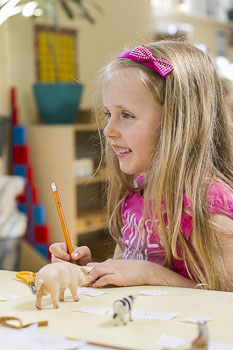Classroom Curriculum
Our classroom curriculum is broken down into five sections:
- Practical Life Exercises
- Sensorial
- Language
- Mathematics
- Cultural Studies

1. Practical Life Exercises
Practical life exercises are basic activities of everyday life. Generally, the activities of Practical Life revolve around four areas:
- Caring for the Self
- Caring for the Environment
- Grace and Courtesy
- Movement of Objects
These exercises help the child gain control in the coordination of their movement, and help the child to gain independence and adapt to their environment. Practical Life exercise also aid the growth and development of the child’s intellect and concentration and will in turn help the child to develop an orderly way of thinking. These activities include dressing frames, washing dishes, table setting, sweeping and polishing exercises.
2. Sensorial Materials
Sensorial materials are scientifically designed to isolate the senses and sharpen the powers of observation. Each set of materials isolates one of the senses. “Sound cylinders” for example, teach the child to match and grade different types of sounds. Through work with the Sensorial materials, the child is given the keys to classifying the things around him, which leads to the child making his own experiences in his environment. Through the classification, the child is also offered the first steps in organizing his intelligence, which then leads to his adapting to his environment.


3. Language curriculum
Language in the Casa Montessori classroom focuses on the following areas:
- Reading
- Writing
- Communication
The Language Programme is designed to meet the young child’s innate need to acquire language.
Significant emphasis is placed on building vocabulary and oral competency.
Through using the Montessori materials, children acquire a rich vocabulary for labeling, describing, comparing and, contrasting their environment and the people in it.
4. Mathematics
The Montessori Mathematics Programme is firmly based on learning through sensorial experience. Children use a wide variety of carefully constructed materials to lead them to an understanding of the value and sequence of numbers 1 to 10. From there they are introduced to larger amounts and learn the concept of making groups of tens, hundreds, thousands. (The decimal system). The children work through exercises that lead to a more abstract understanding of mathematical operations, terminology and concepts.


5. Cultural Studies
The children are introduced to Geography, Botany, Music, Zoology and Science.
Work with the cultural materials helps the children to become aware of the fact that they are part of the large family of humanity.
Simple science experiments that demonstrate the qualities of matter: sink/float; magnetic/non magnetic; solid/liquid; living/non-living are made by the children as part of the study of their environment.
Different themes are incorporated throughout the year and are complemented by special guests, workshops and field trips to enhance the child’s learning experience.
